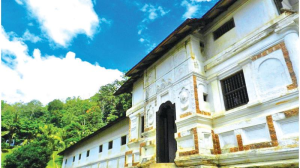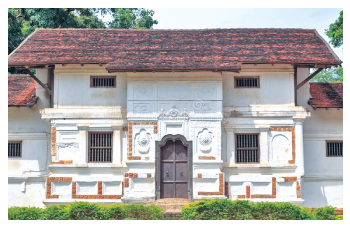A place that most people who visit Kandy do not forget to visit is the ancient palace which was inherited by the Nayakkar Kings centuries ago. This building is now maintained as a museum displaying antiquities belonging to the Kandyan Kingdom. Although many remains of royal palaces are found in Sri Lanka’s ancient kingdoms, this building, which is located next to the Temple of the Tooth is considered to be the most preserved palace out of them.
Starting from Senasammatha Wickramabahu, who made Kandy a kingdom for the first time, 12 rulers have built their palaces on the site where the remains of this palace can be seen. During the reign of King Wimaladharmasuriya 1, who made Kandy a more formal kingdom, the palace was completely renovated. He also built a temple to place the sacred tooth relic, which was then hidden in the Delgamu Raja Maha Vihara in Kuruwita.
After that, it is stated in reports that the kings of the Kandyan Kingdom repaired the palace and lived there from time to time. During the reign of King Senarat, the Portuguese invaded the city of Kandy and destroyed buildings including the palace. After that, the palace was renovated again. The building which can be seen today is the palace where the last king of the Kandyan Kingdom, Sri Wickrama Rajasingha renovated and lived. Many buildings belonging to it are said to have been destroyed during British rule.
According to a map drawn in 1765, the palace complex has had several sections such as the new temple, the old temple, the ambassador’s banquet hall, the place of the throne, the medicines store, the lodge house, the queen’s lodge house, the storeroom, the archery, the armory, the spice store, the stables, the kitchens and rooms where the king’s brothers and their families lived. What can be seen now is a part of the palace with newly added buildings after 1765. In 1798 King Sri Wickrama Rajasingha repaired it by adding a few new features. By the time when the Kandyan Kingdom was acquired by the British, the king and the queens had been living in this palace. In 1815, after the British conquered the Kandyan Kingdom, the palace became the official residence of John Doyle, the British representative in Kandy. At that time, the palace was modified to accommodate the officials. The British rulers used the palace as a government office for a long time and continued to maintain government offices there even after independence. Due to this, the ancient features of the palace had been changed to a great extent. The paintings of maids, lions and swans that had adorned the walls in ancient times had faded away due to plastering. After the Department of Archeology was entrusted with conserving it, the inappropriate elements were removed, and the old style was preserved.
After conservation, the palace has regained its ancient form. The whitewashed building is entered through a wooden door carved with leaves. The door at this location is said to have been made in the 17th century. The front wall is decorated with paintings of sun and moon which are considered as a sign of royalty. Evidence has also been found that the inside of the palace was decorated with wall paintings in the past.
Source: https://www.sundayobserver.lk/2023/01/01/news/ancient-palace-kandy


